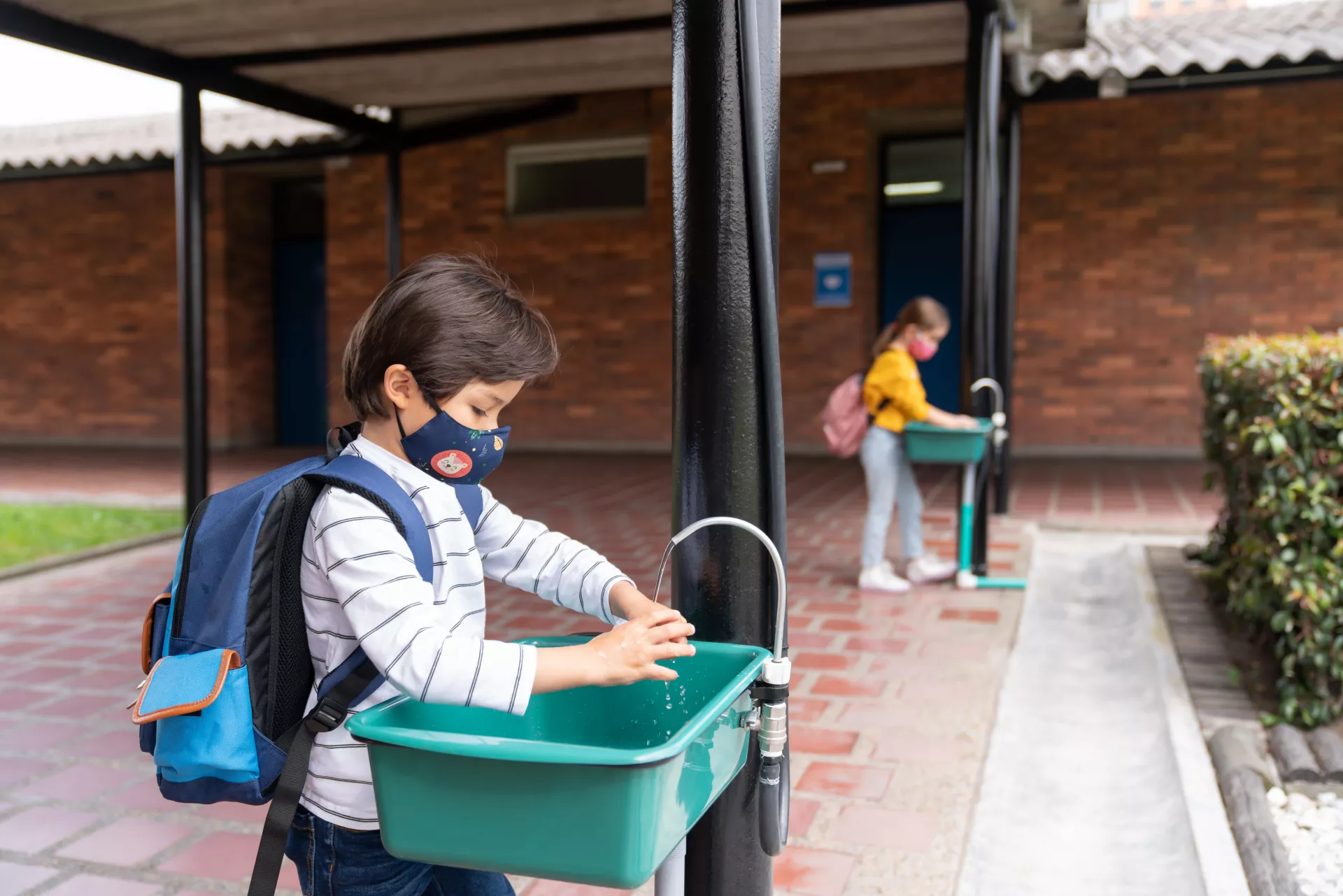Federal Funding Guide
NEA’s Guide to Federal Emergency Aid Amounts, Uses, and Requirements
We have an unprecedented opportunity to create the public schools all our students deserve. The American Rescue Plan Act is the nation's largest investment in public schools ever.

By: National Education Association
Published: May 24, 2021
Share
Now is the time for educators to lead and use their voices to work with parents, communities, and other caring allies for students to ensure these historic resources are used to ensure equitable and just conditions for all of our students.
The Federal Emergency Aid for Public Education: A Guide to Funding Amounts, Uses, and Requirements provides the information needed to advocate on behalf of our students. This guide will help you:
- Understand the available emergency resources for public schools.
- Identify the kinds of activities, programs, and services ARPA supports.
- Advocate for evidence-based solutions for students.
You also can use the ARPA Checklist as a quick way to identify and share your funding priorities.
Download the full funding guide below.
Your State's American Rescue Plan Education Funding & Guide
Click on your state to view stats and download your full state funding guide.
-
Alabama
Total Education Funding
$2.6 billionK-12 Funding
$2 billionElementary and Secondary School Emergency Relief (ESSER) FundHigher Ed Funding
$588 millionHigher Education Emergency Relief Fund (HEERF)State & Local Aid
$4 billion -
Alaska
Total Education Funding
$399.5 millionK-12 Funding
$361 millionElementary and Secondary School Emergency Relief (ESSER) FundHigher Ed Funding
$33 millionHigher Education Emergency Relief Fund (HEERF)State & Local Aid
$1.4 billion -
Arizona
Total Education Funding
$3.3 billionK-12 Funding
$2.6 billionElementary and Secondary School Emergency Relief (ESSER) FundHigher Ed Funding
$668 millionHigher Education Emergency Relief Fund (HEERF)State & Local Aid
$7.6 billion -
Arkansas
Total Education Funding
$1.6 billionK-12 Funding
$1.2 billionElementary and Secondary School Emergency Relief (ESSER) FundHigher Ed Funding
$363 millionHigher Education Emergency Relief Fund (HEERF)State & Local Aid
$2.8 billion -
California
Total Education Funding
$20 billionK-12 Funding
$15.2 billionElementary and Secondary School Emergency Relief (ESSER) FundHigher Ed Funding
$5 billionHigher Education Emergency Relief Fund (HEERF)State & Local Aid
$42.6 billion -
Colorado
Total Education Funding
$1.7 billionK-12 Funding
$1.2 billionElementary and Secondary School Emergency Relief (ESSER) FundHigher Ed Funding
$498.5 millionHigher Education Emergency Relief Fund (HEERF)State & Local Aid
$6 billion -
Connecticut
Total Education Funding
$1.5 billionK-12 Funding
$1.2 billionElementary and Secondary School Emergency Relief (ESSER) FundHigher Ed Funding
$368.5 millionHigher Education Emergency Relief Fund (HEERF)State & Local Aid
$4.4 billion -
Delaware
Total Education Funding
$519 millionK-12 Funding
$413 millionElementary and Secondary School Emergency Relief (ESSER) FundHigher Ed Funding
$100.7 millionHigher Education Emergency Relief Fund (HEERF)State & Local Aid
$1.4 billion -
Florida
Total Education Funding
$9.5 billionK-12 Funding
$7.1 billionElementary and Secondary School Emergency Relief (ESSER) FundHigher Ed Funding
$2.2 billionHigher Education Emergency Relief Fund (HEERF)State & Local Aid
$17.6 billion -
Georgia
Total Education Funding
$5.5 billionK-12 Funding
$4.2 billionElementary and Secondary School Emergency Relief (ESSER) FundHigher Ed Funding
$1.2 billionHigher Education Emergency Relief Fund (HEERF)State & Local Aid
$8.4 billion -
Hawaii
Total Education Funding
$522 millionK-12 Funding
$415 millionElementary and Secondary School Emergency Relief (ESSER) FundHigher Ed Funding
$97.7 millionHigher Education Emergency Relief Fund (HEERF)State & Local Aid
$2.3 billion -
Idaho
Total Education Funding
$661 millionK-12 Funding
$442 millionElementary and Secondary School Emergency Relief (ESSER) FundHigher Ed Funding
$199 millionHigher Education Emergency Relief Fund (HEERF)State & Local Aid
$1.9 billion -
Illinois
Total Education Funding
$6.4 billionK-12 Funding
$5 billionElementary and Secondary School Emergency Relief (ESSER) FundHigher Ed Funding
$1.3 billionHigher Education Emergency Relief Fund (HEERF)State & Local Aid
$13.7 billion -
Indiana
Total Education Funding
$2.8 billionK-12 Funding
$2 billionElementary and Secondary School Emergency Relief (ESSER) FundHigher Ed Funding
$704.9 millionHigher Education Emergency Relief Fund (HEERF)State & Local Aid
$5.8 billion -
Iowa
Total Education Funding
$1.2 billionK-12 Funding
$779 millionElementary and Secondary School Emergency Relief (ESSER) FundHigher Ed Funding
$362 millionHigher Education Emergency Relief Fund (HEERF)State & Local Aid
$2.7 billion -
Kansas
Total Education Funding
$1.2 billionK-12 Funding
$836 millionElementary and Secondary School Emergency Relief (ESSER) FundHigher Ed Funding
$324.3 millionHigher Education Emergency Relief Fund (HEERF)State & Local Aid
$2.7 billion -
Kentucky
Total Education Funding
$2.6 billionK-12 Funding
$2 billionElementary and Secondary School Emergency Relief (ESSER) FundHigher Ed Funding
$459.3 millionHigher Education Emergency Relief Fund (HEERF)State & Local Aid
$4.2 billion -
Louisiana
Total Education Funding
$3.2 billionK-12 Funding
$2.6 billionElementary and Secondary School Emergency Relief (ESSER) FundHigher Ed Funding
$544.4 millionHigher Education Emergency Relief Fund (HEERF)State & Local Aid
$5.2 billion -
Maine
Total Education Funding
$549 millionK-12 Funding
$414 millionElementary and Secondary School Emergency Relief (ESSER) FundHigher Ed Funding
$122.6 millionHigher Education Emergency Relief Fund (HEERF)State & Local Aid
$1.7 billion -
Maryland
Total Education Funding
$2.5 billionK-12 Funding
$1.9 billionElementary and Secondary School Emergency Relief (ESSER) FundHigher Ed Funding
$548.9 millionHigher Education Emergency Relief Fund (HEERF)State & Local Aid
$6.3 billion -
Massachusetts
Total Education Funding
$2.6 billionK-12 Funding
$1.8 billionElementary and Secondary School Emergency Relief (ESSER) FundHigher Ed Funding
$819.3 millionHigher Education Emergency Relief Fund (HEERF)State & Local Aid
$8.1 billion -
Michigan
Total Education Funding
$4.8 billionK-12 Funding
$3.7 billionElementary and Secondary School Emergency Relief (ESSER) FundHigher Ed Funding
$1 billionHigher Education Emergency Relief Fund (HEERF)State & Local Aid
$10.3 billion -
Minnesota
Total Education Funding
$1.9 billionK-12 Funding
$1.3 billionElementary and Secondary School Emergency Relief (ESSER) FundHigher Ed Funding
$547 millionHigher Education Emergency Relief Fund (HEERF)State & Local Aid
$4.9 billion -
Mississippi
Total Education Funding
$2.1 billionK-12 Funding
$1.6 billionElementary and Secondary School Emergency Relief (ESSER) FundHigher Ed Funding
$431.9 millionHigher Education Emergency Relief Fund (HEERF)State & Local Aid
$2.9 billion -
Missouri
Total Education Funding
$2.6 billionK-12 Funding
$1.9 billionElementary and Secondary School Emergency Relief (ESSER) FundHigher Ed Funding
$630.4 millionHigher Education Emergency Relief Fund (HEERF)State & Local Aid
$5.5 billion -
Montana
Total Education Funding
$490 millionK-12 Funding
$384 millionElementary and Secondary School Emergency Relief (ESSER) FundHigher Ed Funding
$93.6 millionHigher Education Emergency Relief Fund (HEERF)State & Local Aid
$1.4 billion -
Nebraska
Total Education Funding
$775 millionK-12 Funding
$550 millionElementary and Secondary School Emergency Relief (ESSER) FundHigher Ed Funding
$209.2 millionHigher Education Emergency Relief Fund (HEERF)State & Local Aid
1.8 billion -
Nevada
Total Education Funding
$1.3 billionK-12 Funding
$1 billionElementary and Secondary School Emergency Relief (ESSER) FundHigher Ed Funding
$203 millionHigher Education Emergency Relief Fund (HEERF)State & Local Aid
$4.1 billion -
New Hampshire
Total Education Funding
$525 millionK-12 Funding
$352 millionElementary and Secondary School Emergency Relief (ESSER) FundHigher Ed Funding
$165.1 millionHigher Education Emergency Relief Fund (HEERF)State & Local Aid
$1.5 billion -
New Jersey
Total Education Funding
$3.7 billionK-12 Funding
$2.7 billionElementary and Secondary School Emergency Relief (ESSER) FundHigher Ed Funding
$901.5 millionHigher Education Emergency Relief Fund (HEERF)State & local Aid
$10.2 billion -
New Mexico
Total Education Funding
$1.2 billionK-12 Funding
$985 millionElementary and Secondary School Emergency Relief (ESSER) FundHigher Ed Funding
$209.6 millionHigher Education Emergency Relief Fund (HEERF)State & Local Aid
$2.5 billion -
New York
Total Education Funding
$11.9 billionK-12 Funding
$9 billionElementary and Secondary School Emergency Relief (ESSER) FundHigher Ed Funding
$2.6 billionHigher Education Emergency Relief Fund (HEERF)State & Local Aid
$23.8 billion -
North Carolina
Total Education Funding
$4.8 billionK-12 Funding
$3.6 billionElementary and Secondary School Emergency Relief (ESSER) FundHigher Ed Funding
$1.3 billionHigher Education Emergency Relief Fund (HEERF)State & Local Aid
$8.9 billion -
North Dakota
Total Education Funding
$380 millionK-12 Funding
$307 millionElementary and Secondary School Emergency Relief (ESSER) FundHigher Ed Funding
$69.6 millionHigher Education Emergency Relief Fund (HEERF)State & Local Aid
$1.4 billion -
Ohio
Total Education Funding
$5.7 billionK-12 Funding
$4.5 billionElementary and Secondary School Emergency Relief (ESSER) FundHigher Ed Funding
$1.13 billionHigher Education Emergency Relief Fund (HEERF)State & Local Aid
$11.2 billion -
Oklahoma
Total Education Funding
$1.96 billionK-12 Funding
$1.5 billionElementary and Secondary School Emergency Relief (ESSER) FundHigher Ed Funding
$427 millionHigher Education Emergency Relief Fund (HEERF)State & Local Aid
$3.6 billion -
Oregon
Total Education Funding
$1.5 billionK-12 Funding
$1.1 billionElementary and Secondary School Emergency Relief (ESSER) FundHigher Ed Funding
$400 millionHigher Education Emergency Relief Fund (HEERF)State & Local Aid
$4.2 billion -
Pennsylvania
Total Education Funding
$6.5 billionK-12 Funding
$5 billionElementary and Secondary School Emergency Relief (ESSER) FundHigher Ed Funding
$1.3 billionHigher Education Emergency Relief Fund (HEERF)State & Local Aid
$13.7 billion -
Rhode Island
Total Education Funding
$604 millionK-12 Funding
$417 millionElementary and Secondary School Emergency Relief (ESSER) FundHigher Ed Funding
$179.2 millionHigher Education Emergency Relief Fund (HEERF)State & Local Aid
$1.8 billion -
South Carolina
Total Education Funding
$2.7 billionK-12 Funding
$2 billionElementary and Secondary School Emergency Relief (ESSER) FundHigher Ed Funding
$522 millionHigher Education Emergency Relief Fund (HEERF)State & Local Aid
$3.9 billion -
South Dakota
Total Education Funding
$472 millionK-12 Funding
$348 millionElementary and Secondary School Emergency Relief (ESSER) FundHigher Ed Funding
$79.7 millionHigher Education Emergency Relief Fund (HEERF)State & Local Aid
$1.4 billion -
Tennessee
Total Education Funding
$3.3 billionK-12 Funding
$2.5 billionElementary and Secondary School Emergency Relief (ESSER) FundHigher Ed Funding
$698.8 millionHigher Education Emergency Relief Fund (HEERF)State & Local Aid
$6.3 billion -
Texas
Total Education Funding
$15.7 billionK-12 Funding
$12.5 millionElementary and Secondary School Emergency Relief (ESSER) FundHigher Ed Funding
$3 billionHigher Education Emergency Relief Fund (HEERF)State & Local Aid
$27.6 billion -
Utah
Total Education Funding
$1.1 billionK-12 Funding
$620 millionElementary and Secondary School Emergency Relief (ESSER) FundHigher Ed Funding
$497.8 millionHigher Education Emergency Relief Fund (HEERF)State & Local Aid
$2.7 billion -
Vermont
Total Education Funding
$356 millionK-12 Funding
$287 millionElementary and Secondary School Emergency Relief (ESSER) FundHigher Ed Funding
$64.8 millionHigher Education Emergency Relief Fund (HEERF)State & Local Aid
$1.363 billion -
Virginia
Total Education Funding
$3 billionK-12 Funding
$2.1 billionElementary and Secondary School Emergency Relief (ESSER) FundHigher Ed Funding
$843.2 millionHigher Education Emergency Relief Fund (HEERF)State & Local Aid
$6.875 billion -
Washington
Total Education Funding
$2.5 billionK-12 Funding
$1.9 billionElementary and Secondary School Emergency Relief (ESSER) FundHigher Ed Funding
$656.1 millionHigher Education Emergency Relief Fund (HEERF)State & Local Aid
$7.103 billion -
Washington, D.C.
Total Education Funding
$506 millionK-12 Funding
$97 millionElementary and Secondary School Emergency Relief (ESSER) FundHigher Ed Funding
$112.7 millionHigher Education Emergency Relief Fund (HEERF)State & Local Aid
$1.6 billion -
West Virginia
Total Education Funding
$964 millionK-12 Funding
$776 millionElementary and Secondary School Emergency Relief (ESSER) FundHigher Ed Funding
$189.1 millionHigher Education Emergency Relief Fund (HEERF)State & Local Aid
$2 billion -
Wisconsin
Total Education Funding
$2.1 billionK-12 Funding
$1.5 billionElementary and Secondary School Emergency Relief (ESSER) FundHigher Ed Funding
$556.7 millionHigher Education Emergency Relief Fund (HEERF)State & Local Aid
$5.7 billion -
Wyoming
Total Education Funding
$354 millionK-12 Funding
$305 millionElementary and Secondary School Emergency Relief (ESSER) FundHigher Ed Funding
$44.1 millionHigher Education Emergency Relief Fund (HEERF)State & Local Aid
$1.4 billion
References
Are you an affiliate?
Jump to updates, opportunities, and resources for NEA state and local affiliates.

Safe and Just Schools in 2022 and Beyond
NEA is here to ensure we rebuild schools with an emphasis on equity, return to the school safely, protect the most vulnerable students, and help educators navigate their rights and responsibilities amidst the COVID-19 crisis.
Stay Informed We'll come to you
We're here to help you succeed in your career, advocate for public school students, and stay up to date on the latest education news. Sign up to stay informed
